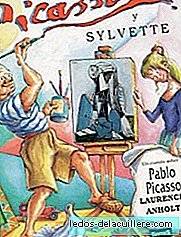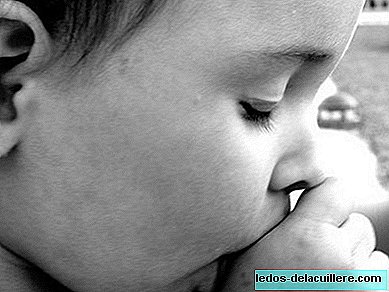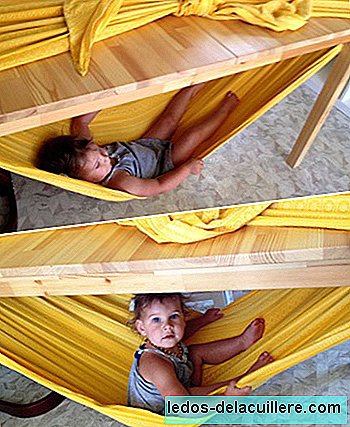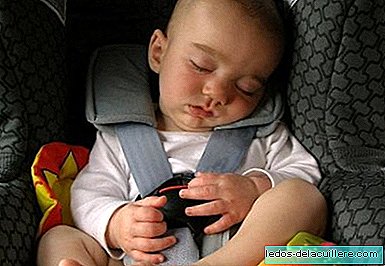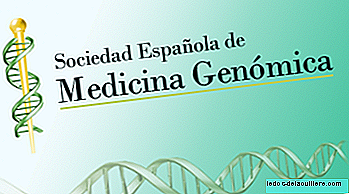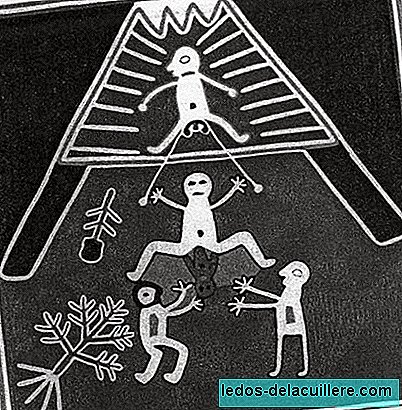
Surely many parents who read us suffered the handshakes of the parturient mother in their hands. But, there really is a culture in which the man sympathizes so much with the pain of the woman during childbirth that he lets himself stretch from the genitals? I have been inquiring about this image and the text that circulates by email and that says yes, that the tradition in wixarikas or Huicholes births is that, during childbirth, while the woman undergoes contractions, stretch from tied strings to the genitals of your partner.
The image is a painting on Huichol wood, contemporary, found in California (United States). It is accompanied by an appointment corresponding to a work by Adele Getty entitled "The goddess. Mother of living nature ”:
The act of giving birth, be it a son, an idea or a work of art, is always accompanied by pain. The Huichol Indians think that the woman's partner must share the pain and pleasure of giving birth: that is why, while she is in labor, the husband sits on the beams located above his head with a rope tied to the testicles. Each time she has a contraction, the parturient pulls the rope. In the end, the husband feels as much joy for the birth of the child as the wife or even more! This custom of sharing the pains of childbirth, in which the man maintains a sympathetic attitude of brooding before the arrival of the son, is widespread among many natives.
The Huichol or Wixarikas Indians they inhabit the central west of Mexico in the Sierra Madre Occidental, mainly in the States of Jalisco and Nayarit. They call themselves wixarica or 'the people' in their language called by the linguists Wixaritari or vaniuki (known as the Huichola language), which belongs to the Aztec family of languages.
A fundamental part of their religion and culture is the collection and ritual consumption of peyote (a cactus with hallucinogenic properties), an act that, if this practice were true during childbirth, man would probably consume.
The work of Adele Getty exists, it is published in Spanish by Editorial Debate (Madrid, 1996) and the original title of it is “Goddess. Mother of Living Nature. " It is a work that analyzes goddesses related to fertility and motherhood and how to give birth in different cultures. In theory, this quote is taken from page 68 of the Spanish edition. However, I have not been able to contrast this information, since the book is not easy to find and it is not registered on the Internet either.
I have also read a lot about this interesting ethnic group, but I have not been able to find references to the tradition regarding the time of delivery. You can access its website developed by the National Commission for the Development of Indigenous Peoples to publicize the wealth of the people of the Huicholes or Wixarikas.
What I have been able to find is a point in common with the Nahualt, Aztec (and many other cultures) culture, with which the Huichols are related, and that is that childbirth, like any creation, is associated with benign pain, to a positive effort, since it entails a desired result. Patience, the pain of creation, dignifies and transcends, why would it be only the woman who enjoyed that elevation? Self-imposed pain would be a kind of sacrifice that would honor man. However, I have not been able to find references of the presence of the man at the time of delivery (yes of the midwife who helps the woman).

But seeing some manifestations of contemporary Huichol crafts, I find this other representation of childbirth (on these lines), inspired by the Huichol tradition and mythology, which does not refer to the pain of man.
However, I would not be surprised if this ritual has something true, giving sacred character at birth and as a way to share a crucial and unrepeatable vital moment. And although I do not believe that this ritual is practiced today, it may be that in the past a similar situation was carried out, perhaps not as intense as the one described in the first image and the quotation of Getty's work, about all because of the danger of running out of more descendants ...
Nowadays, at most, the man lets himself squeeze his hand during the contractions, sharing some of the pain (on the other hand, for what else ?; the company and the support is enough for me). However, it is clear that during many times childbirth has not only been a matter of women, and although those scenes in which the father found out about distance or late birth are true, it is increasingly common to accompany during childbirth.
Accompany during childbirth, share the joy and effort of birth and show solidarity with the woman's pain, but to what extent? And our readers, do you know anything more about this practice of share pain during childbirth? Reality or legend? Has anyone been involved in any way painful during the delivery of his wife?



